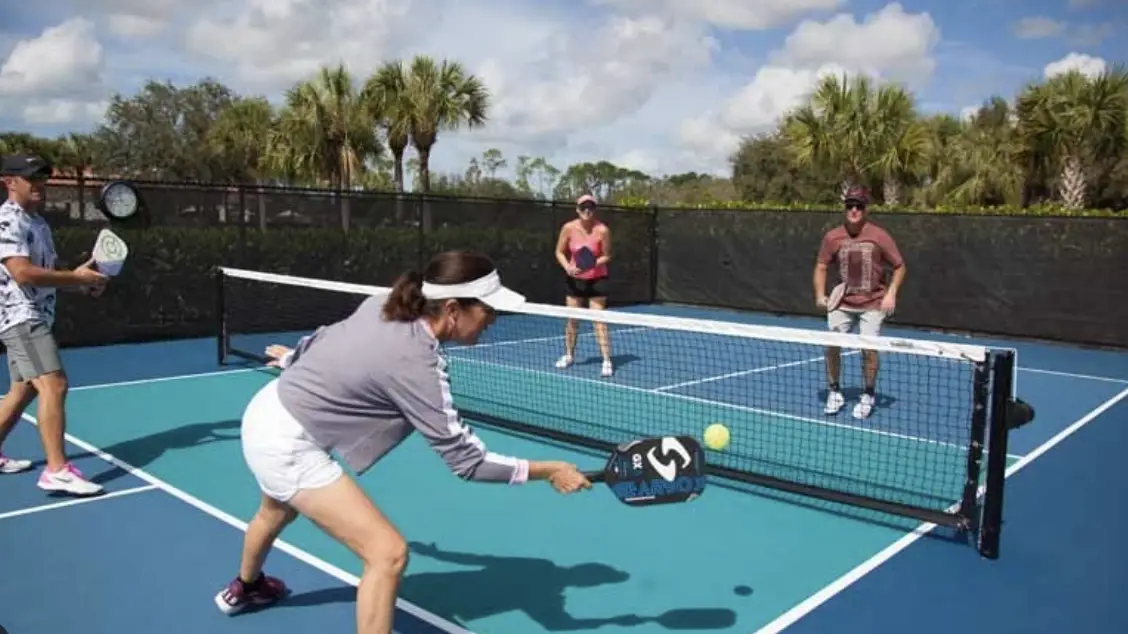Pickleball, a fast-paced and exciting sport, has been gaining popularity worldwide. Combining elements of tennis, badminton, and ping pong, it offers a unique and engaging experience for players of all ages and skill levels. If you’re new to pickleball and curious about this fun-filled game, you’ve come to the right place. In this blog post, we’ll explore the basics of pickleball, from the court layout to the equipment and rules, helping you get started on your pickleball journey.
- Court Layout:
Pickleball is typically played on a court with similar dimensions to a badminton court. The court is 20 feet wide and 44 feet long, with a centerline dividing it into two equal halves. There are non-volley zones, also known as the kitchen or the no-volley zone, located on each side of the net, extending 7 feet from the net.
- Equipment:
To play pickleball, you’ll need a few essential pieces of equipment:
- Pickleball Paddle: Similar in size and shape to a ping pong paddle, a pickleball paddle is used to hit the ball. Paddles are available in various materials and weights, allowing players to find a paddle that suits their playing style.
- Pickleball: The ball used in pickleball resembles a wiffle ball, with unique hole patterns that reduce its speed. Outdoor balls are typically used for outdoor play, while indoor balls are designed for indoor courts.
- Court Shoes: Proper court shoes with non-marking soles provide the necessary traction and support for swift movements on the court.
- Basic Rules:
The objective of pickleball is to score points by hitting the ball over the net and landing it within the boundaries of the opponent’s court. Here are a few key rules to get you started:
- Serve: The serving player must stand behind the baseline and serve the ball diagonally to the opponent’s service area. The serve must clear the non-volley zone and land within the opponent’s service court.
- Double Bounce Rule: After the serve, each team must let the ball bounce once on their side before hitting it back. Once the ball has bounced on each side, players can either volley the ball (hit it in the air without letting it bounce) or play it off the bounce.
- Non-Volley Zone: Players cannot enter the non-volley zone and hit the ball directly out of the air (volley) unless the ball has bounced outside the non-volley zone.
- Scoring: Pickleball typically uses rally scoring, where points can be scored by the serving or receiving team. Games are usually played to 11 or 15 points, with a win by two points.
- Playing Strategies:
As you become more familiar with the game, you’ll discover various strategies to improve your pickleball skills. Here are a few basic strategies to consider:
- Placement: Focus on placing your shots strategically, aiming for areas that are difficult for your opponents to reach.
- Communication: Communication with your partner is crucial in doubles play. Keep each other informed about your position on the court and coordinate your shots.
- Dinking: Dinking refers to hitting the ball softly over the net, close to the net. Mastering the art of dinking can be a valuable strategy, as it allows you to control the pace of the game and set up winning shots.
Conclusion:
Pickleball is a fun and inclusive sport that offers an enjoyable experience for players of all ages and skill levels. With its unique combination of elements from various racket sports, pickleball provides a fresh and engaging alternative to traditional games. By familiarizing yourself with the court layout, equipment, basic rules, and playing strategies, you can confidently step onto the pickleball court and start enjoying the game. So grab your paddle, find a local court, and get ready to experience the thrill and camaraderie of pickleball. Remember, practice and persistence will help you improve your skills and fully embrace the exciting world of pickleball.
